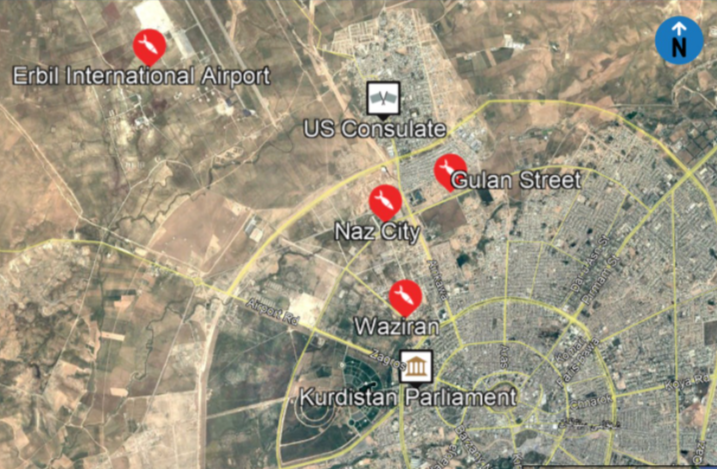Executive Summary
- During the evening hours of February 15, 14 107 mm rockets were launched towards Erbil. Three landed within a US base located near Erbil International Airport. One US military personnel and four US civilian contractors were wounded as a result of the attack.
- This development is highly notable given the rarity of such incidents in Erbil as well as the scale and scope of the attack. Given the precedent, target, and type of rockets used, the attack was likely perpetrated by Iran-backed Shiite militias.
- Casualties to US citizens are generally considered a “red line” by Washington and the development thus constitutes a significant escalation. The US will likely be compelled to retaliate over the coming days. This will likely manifest in the form of targeted strikes against Iran-backed Shiite militias and may lead to back-and-forth hostilities between such groups and the US in Iraq. This, in turn, will escalate geopolitical tensions in the wider region between the US and Iran.
- It is advised to avoid nonessential travel to Iraq, including Baghdad, Basra, and Erbil, at this time due to the recent rocket attack and the heightened risk of further security incidents over the coming days and weeks. Those operating in the country are advised to consult with us at [email protected].
Please be advised
- During the morning hours of February 16 (local time), the US-led Coalition spokesperson, Wayne Marotto, announced that eight civilian contractors, of whom four were US nationals, and one US serviceman, were wounded during the rocket attack that was launched towards the US base near Erbil International Airport on February 15. One other civilian contractor, a non-US national, was also killed.
- According to the statement, a total of 14 “107 mm rockets” were launched, with three having landed within the US base grounds. Additional reports indicate that three other rockets landed in the Kani Qirzhala neighborhood. Rockets also reportedly landed near Erbil’s Gulan Street in Naz city as well as in Waziran.
- Additional picture material of two of the rockets that landed outside Erbil near a Peshmerga base, the military forces of the Kurdistan Regional Government (KRG), indicate that they were Iran-made 107 mm Fajr-1 rockets. Such rockets have a range of 8-10 km.
- A group named Saraya Awliya al-Dam, reported to be linked to Iran, claimed responsibility for the attack, stating that it targeted the “American occupation” in Iraq. However, it has provided no evidence for its claim. It also threatened to conduct more attacks on Iraqi Kurdistan.
- KRG Prime Minister, Masrour Barzani, stated that they will work closely with the US to coordinate the investigation into the perpetrators.
- The US Secretary of State Anthony Blinken reportedly said that Washington is “outraged” by the attack would hold those responsible accountable.
Assessments & Forecast
- This development is highly notable due to the rarity of such incidents being recorded in Erbil Province, particularly in Erbil city. However, this is not without precedent. On September 30, 2020, six rockets were similarly launched towards a US-led Coalition base near Erbil International Airport. That said, no casualties or material damage were reported by the US following this attack. Therefore, the latest incident constitutes a significant escalation both due to the scope of the attack and the fact that multiple casualties, including US military personnel and civilian contractors, were recorded. Such attacks are generally conducted by Iran-backed Shiite militias aiming to compel the US forces to leave Iraq, as they perceive the US’s presence to be a violation of Iraqi sovereignty, rendering them the likely perpetrators of the latest incident. This is bolstered by reports that the Iran-made Fajr-1 rocket was used, although this is not conclusive evidence, as other Iraq-based groups are capable of acquiring such weapons. Regardless, given that such Iran-backed groups are known to also launch rockets towards key US interests in Iraq, they are the most likely perpetrator.
- On October 10, 2020, an unspecified number of Iran-backed Shiite militias led by Iran-linked Kata’ib Hezbollah, who had formed the “Iraqi Resistance” Coalition, announced a suspension of attacks against US interests. It further declared that it had set a “limited” timeline for US-led Coalition forces to leave Iraq or it will be forced to “move to an advanced combat stage”. Notwithstanding, IED attacks targeting US-linked convoys in Iraq have increased over the past weeks. For instance, on February 11, an IED attack targeting a US-led Coalition-linked support convoy in Latifiya, approximately 35 km, south of Baghdad, was recorded. Therefore, taken together with another major rocket attack against US interests on December 20, 2020, when damage was caused to the US Embassy compound in Baghdad, which was also highly likely to have been conducted by Shiite militias, the latest incident likely signals a departure from this unilateral ceasefire and a return to systematic rocket attacks against US interests within Iraq.
- The latest incident indicates that the perpetrators had relatively high capabilities. This is because the majority of rocket attacks by Iran-backed forces are conducted within a relatively close range of the intended target. This is given that the range of the 107 mm rocket is approximately 8-10 km. Hence, it is likely that the perpetrators were able to infiltrate into KRG-administered territories, which are generally far more secure than other areas of Iraq and where Shiite militias in the Popular Mobilization Units (PMU) have far less influence and freedom to conduct the attack. This is in contrast to Kirkuk, located south of Erbil, where the PMU reportedly established in December 2020 the “Abu-Mahdi al-Muhandis Force”, after Abu Mahdi al-Muhandis, the deputy commander of the PMU, killed in a January 2020 airstrike by the US in Baghdad. Thus, the fact that Shiite militias seemingly entered Erbil in possession of rockets and launched them from within the city’s environs points to significant gaps in security protocols surrounding Erbil city and Erbil International Airport. FORECAST: This, therefore, indicates the potential risk of additional such attacks in the Erbil region over the coming days and weeks.
- Meanwhile, the scale and target of the attack highlight Iran-backed Shiite militias’ willingness and increased efforts to expand the scope of their operations against US-linked interests in Iraq. This may be attributed to the current relations between the US and Iran following the January 20 inauguration of US President Joe Biden. This is because, while Biden has indicated his willingness to lift the US’s current sanctions on Iran, he has maintained that Iran must first comply with the stipulations of the Joint Comprehensive Plan of Action (JCPOA). Meanwhile, Iran has stated that it will continue to build its nuclear capacities until the US returns to the JCPOA and lifts its sanctions on the former. In this context, it is possible that the latest attack was partly directed by Iran as part of an effort to put pressure on the US to return to negotiations with the former, especially ahead of the February 21 deadline that Tehran has provided, after which it has warned that it will expel the International Atomic Energy Agency (IAEA) inspectors. This assessment is further evidenced by the scope and scale of the latest attack, which thereby indicates that the perpetrators may have been able to bolster their capabilities with additional support. Should this be confirmed, it would constitute a significant escalation in geopolitical tensions between the US and Iran and likely impede future negotiations.
- That said, it is also possible that the latest attack was a more Iraqi nationalist-oriented effort to compel Biden to withdraw the remaining US troops in the country, without Iranian direction or having been carried out on behalf of Tehran. This is because while Biden has not indicated any specific US policy towards Iraq, he is likely unwilling to increase Washington’s military footprint in the country. Hence, by conducting such an attack, resulting in US casualties, the perpetrators may have aimed to increase the risk for the US operating in Iraq.
- FORECAST: Given that the US has confirmed multiple casualties to its citizens, which constitutes a significant escalation and generally the crossing of a “red line”, Washington will likely be compelled to retaliate in order to project its intolerance of threats to its personnel and interests in Iraq. This is evidenced by the fact that in December 2019, the US carried out strikes against five Kata’ib Hezbollah facilities in Iraq and Syria after a series of rocket attacks targeting Iraqi army bases housing US troops and the firing of projectiles towards the US Embassy in Baghdad’s Green Zone. This was followed by the January 2020 US-perpetrated killing of Qassem Soleimani, the Islamic Revolutionary Guards Corps (IRGC)-Quds Force (QF) commander.
- FORECAST: Against this backdrop, the US may resort to targeted strikes against the perpetrators of the latest attack or other known hardline Iran-backed Shiite groups, such as Kata’ib Hezbollah or Asa’ib Ahl al-Haq, both of which are considered “terrorist organizations” by Washington, and it, therefore, may hold them responsible for the attack. The US is liable to consider Saraya Awliya al-Dam’s claim of responsibility to be a front to provide more prominent and well-established groups a modicum of plausible deniability. This would constitute a coordinated effort on the part of the larger PMU alliance to deter any targeted US strikes against its personnel and infrastructure or evade any operations by the Iraqi government. Regardless, should the US conduct an attack, there is a possibility of back-and-forth hostilities as it may prompt additional action by Shiite militias against US interests. This will likely lead to a broader escalation of tensions in the wider region. Moreover, Washington will likely exert pressure on the Iraqi government to apprehend the perpetrators. However, this will increase tensions between the Shiite groups in Iraq and the US. Regardless, additional attacks by Iran-backed Shiite militias targeting US-linked interests across Iraq, including IED attacks against US-contracted logistics convoys, are likely to occur over the coming days and weeks.
Recommendations
- It is advised to avoid nonessential travel to Iraq, including Baghdad, Basra, and Erbil, at this time due to the recent rocket attack and the heightened risk of further security incidents over the coming days and weeks. Those operating in the country are advised to consult with us at [email protected].
- Those remaining in Erbil are advised to maintain heightened vigilance and adhere to security precautions regarding the threat of militant attacks and civil unrest.
- It is advised to defer all travel to Baghdad at this time due to the daily threat of militancy in the capital, violence in areas surrounding the city, and the risk of a broad deterioration of security conditions.
- For those remaining in Baghdad, it is advised to restrict travel to the Green Zone and ensure that contingency and emergency evacuation plans are updated. Contact us for itinerary and contingency support options.
- Travel to Anbar, Nineveh, Salahuddin, Kirkuk, and Diyala provinces should be avoided at this time due to ongoing counter-militancy operations and militant attacks. Those operating in these regions are advised to contact us for itinerary and contingency support measures, including evacuation options, given the deterioration in the security situation.
- As a general precaution, it is advised that any travel, particularly in outlying areas, be conducted in armored vehicles, with proper security escorts and coordination with authorities.


